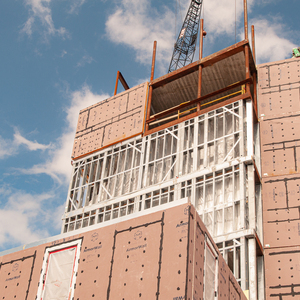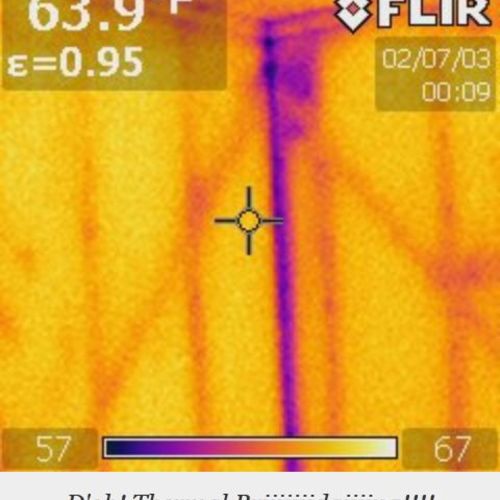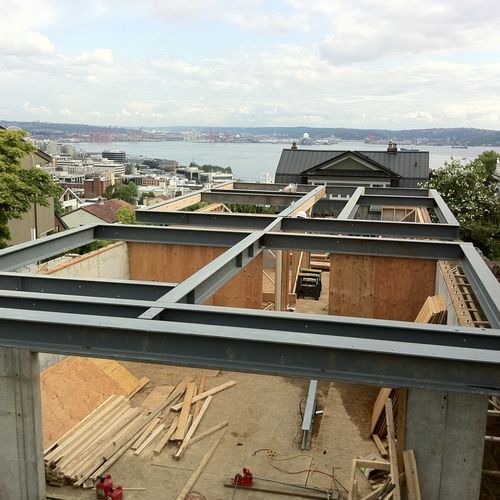
Image Credit: Charles Miller/Fine Homebuilding magazine
Sal Lombardo is planning a new home in the New York-New Jersey area (Climate Zone 5) and is looking at a long list of high-performance construction options: double-stud walls, structural insulated panels, insulating concrete forms, Larsen trusses, and walls built with light-gauge steel framing.
Wait a minute. Steel framing, as in the stuff that leaks heat through the building envelope like a proverbial sieve? Maybe, Lombardo says, it deserves another look.
“Steel seems like a really good option,” Lombardo writes in a Q&A post at GreenBuildingAdvisor. “Almost unheard of in my area, despite being upwards of 60% recycled, it lasts forever (relatively speaking), is super strong, straight, creates minimal waste, is not affected by termites, pests, or mold, and is equal or close to wood in cost (depending on who you ask).
“I know it has very high thermal conductivity. However, there are configurations that can abate this significantly,” he adds, such as a double layer of 2-in. polyiso foam on the exterior.
“Why isn’t it more popular?” Lombardo asks. “Am I missing something?”
Those questions are the topic for this month’s Q&A Spotlight.
You’ll get a good, but not great, wall
According to GBA senior editor Martin Holladay, the main problem with steel framing is thermal bridging. Because the effect is so pronounced, all of the wall insulation should go on the outside. Insulation placed in stud cavities won’t accomplish much.
“You’re right that it’s possible to install two layers of 2-inch polyiso, giving you R-26,” Holladay writes, “That’s OK, but it’s not great.”
If Lombardo could add even more insulation on the outside of the wall — 6 in. rather than the 4 in. he has proposed — he’ll end…
Weekly Newsletter
Get building science and energy efficiency advice, plus special offers, in your inbox.

This article is only available to GBA Prime Members
Sign up for a free trial and get instant access to this article as well as GBA’s complete library of premium articles and construction details.
Start Free TrialAlready a member? Log in















11 Comments
in reponse to the lead question here ..
"""Is there a place for this thermally conductive material in high-performance buildings? """
i'd put the emphasis on the word " IN " ...as in " INside "
Although i am a complete n00b at all this game, i was questionning in wall insulation in any building type even before beginning to understand the whys ...this type of info only contributes to adding more to it.
We need to move insulation to the exterior and stop worrying about all the condensation and thermal bridging problems.
Blueskybuildings offer some embedded fastening strips in their exterior insulation, this type of product is what needs to be designed more and use for thick exterior insulation shells.
Probably many other manufacturer of rigid insulation also provide similar products, and we should favor those.
The only problem i see with steel framing is how to get a perfect seal.
Maybe using some fiberglass faced polyisoboards or something similar, screwed to the exterior of the building and then wraped completely with peel&stick similarly to Remote/Persist ,
Could be done with SIS product from DOW also??
Then, why not add something like 1" of insulation to the interior of the wall, in between metal studs ?
a wall calculated dew point/vapor membrane is possible as pointed out by Martin a few times,
and i don't see why covering ~90% of the free space inside the walls, leaving the metal frame incovered couldn't help with efficiency.
Then again, if we look at the Blueskybulding system, a different approach is necessary for air sealing and insulation placement/fastening.
Metal framing has been used in commercial/industrial buildings for decades,
why couldn't it be used successfully in green residential buildings ?
As for the fire resistance, i'd like to see a light gauge residential building ( not a 6 story multi building please ) after a regular fire ... i still believe that some are referring to beam type steel construction in large buildings with very high fire temperatures fueled by uncommon in residential combustibles. I do understand the weakness of steel tensile VS temperature,
but the steel has to reach this temperature before it plasticizes, and fire needs fuel.
I don't believe a wood framed house where a 5gallon of car fuel was light would give more chance to inhabitants than steel framed one... regular residential fire usually start slowly in a specific location, and need combustible material to spread before temperature gets high and melt everything down. Likely by then, everybody is out already. ( hopefully! )
Commonsense question
What amount of insulation would be needed on the exterior and interior to get the thermal conductivity to that of a wood stud without?
It would seem like you would just add an R-5 to the exterior and an R-5 to the interior and then your cavity insulation would become significant.
If you are going to use a double stud system then it would have all the advantage at that point unless I am missing something.
Response to Brian
Brian,
Of course each layer of rigid foam improves the thermal performance of a steel-framed wall. If you want to build a steel-framed wall with rigid foam on the exterior, and rigid foam on the interior, you are of course free to do so.
Most builders would conclude, however, that such a wall is fussy and expensive to build, and not worth the trouble compared to other easier (and more affordable) options.
in response
Martin,
I understand the productivity of certain building systems but if we are just interested in the easiest or most productive way we would not have green building advisor.
I am wondering at what point would the conductivity of steel become irrelevant compared to wood? When we establish that then we can dial in the details based on the climate zone and so on.
Response to Brian
Brian,
Q. "At what point would the conductivity of steel become irrelevant compared to wood?"
A. As the article on this page explains: when all of the insulation is installed on the exterior side of the steel framing.
Brian : i would add that in
Brian : i would add that in between studs, once can add insulation depending on the stud depths..
might be labor intensive, but it might same 1-2" of exterior insulation if high R is required.
It would be very wise to leave the studs all uncovred, and to make sure that the cavity is not filled
so that warm air from the interior can always work around and the structural parts are at near interior temps, this would prevent condensation on frame parts, but still permit some higher R.
I do not believe that using light gauge with something akind fo SIS panels as sheathing and exterior insulation would have a large impact on labor cost vs regular wood framing..not with an ligh gauge steel framing experienced team.
And to produce as straight and true walls as with metal framing, a wood framing team would need to invest alot more time and discard many bad wood material, probably even surpassing labor cost of the light gauge team.
Of course steel studs can work
As the article indicates, if you build a "perfect wall" as described by BSC, then building with steel studs is no different than wood studs. The details of the "perfect wall" are key though. As a society we have built many commercial buildings with steel studs, there is no reason we should not be able to do it with residential buildings. Whether we have the designers and builders skilled enough to do it is another question.
Steel has properties that are both beneficial and detrimental when building. The weight to strength ratio is great. Its straight, and available in very long lengths. Fire is an issue though. Given that steel can lose significant strength at 1000 degrees (less than half of its melting point), and a house fire can reach that temperature in a few minutes, structural failure is a serious concern. Even though I am personally not a fan of sprinklers in wood stud buildings, fire sprinklers should probably be mandatory in a steel stud house given the potential for structural failure in such a short time.
Steel Framing
I'd like to echo Mr. Fisher's comments and add this. If I'm not mistaken, most, if not all, new Japanese production homes use steel framing. However, the Japanese are very smart about how they use steel. They take advantage of steel's strength and don't do stick for stick replacement like our framers do (they really like open floor plans which were based on traditional design which use these massive cedar beams. Of course they don't have any more massive cedars, but they are the most impressive wood framed buildings I've ever seen). Second, they don't like fires either so they fireproof the steel, just like we do in commercial. Third, they put the insulation on the outside of the wall. And, by the way, they've been building zero energy homes since the early 2000s.... thousands of them with steel framing. But they build their produciton homes in factories and use only their own employess (sorry, no subs. When I spoke to Japanese PV folks about how we build homes they looked at be dumbfounded and asked "you let other companies' workers build your house?!). So, I think steel could be used and has a place in new home production. The real issue is that produciton home building is stuck in its won't change, obselete mind set of building homes the way they build homes. And I don't have an answer to that. The bottom line is that the Japanese wouldn't tolerate the way we build a house, but for some reason we do. Cost is a relative concept.....
Response to Mike Keesee
Mike,
It's ironic that you posted this comment ("The bottom line is that the Japanese wouldn't tolerate the way we build a house, but for some reason we do") on the same day that Eric Matsuzawa posted a question on our Q&A forum that describes an unbelievably sub-standard wall system used in Japan: Energy inefficient Japanese walls.
Steel Framing
Hi Martin,
I can't comment on all Japanese builders, just the ones I'm familar with- the large produciton builders like Misawa, Panasonic or Sekisui. But th eposting looks like a site built, custom, site built wood frame wall to me, not the modular models I've seen. I imagine that there's low end builders in Japan, too.
steel studs
I have used 1 1/2" and 7/8" hats running horz. The 1 1/2 on the out side and the 7/8 on the inside. This cuts down on the heat transfer. I though of using a thin rubber spacer between the hat and the stud but have not tried this yet. I used the spray foam in the walls. It goes behind the studs and gives good coverage.
I lived in this house for 3 years and had no problems with this system.
Log in or become a member to post a comment.
Sign up Log in